
I have been a general dentist for 30 years. During this time, I have seen the spectrum of the public’s dental needs change. To reveal this change, one does not have to look much further than a comprehensive exam on a 25-year-old patient. The exam will commonly reveal an individual with minimal or no previous restorative treatment and a healthy, complete dentition. If one is living near an urban center, on average, these findings are quite consistent.
We see these healthy results because the dental profession has done an amazing job in educating the general public about the importance of oral hygiene. This education and the public’s desire to maintain their teeth for as long as possible, unlike older generations, have resulted in a decline in caries, periodontal disease, and edentulous spaces, as well as in the need for the high-speed handpiece.
 |
| Figure 2: Orthodontically treating this case of reduced vertical dimension improved the vertical overbite/horizontal overjet relationship. |
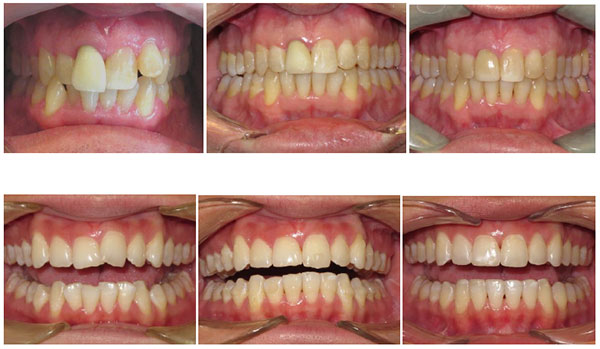 |
| Figure 3: Aesthetic dilemmas may be treated by the nonsurgical levelling of gingival margins. |
The United States Census Bureau has forecast a population of 330,000,000 for 2019. The estimated population over the age of 55 years, representing approximately 29% of the country, will be 95,700,000. It is in this segment of the population of Americans that the demand for dental services exists today. Many of them have mutilated, worn dentition and have a desire to maintain their remaining teeth. The general dentist, with proper education and training, can provide exceptional dental treatment for these patients.
Many years ago, all dentistry was extraction dentistry. Over time, restorative dentistry came on the scene to restore and preserve teeth. As dentistry evolved, so did the forensic, preventive, paediatric, periodontic, orthodontic, endodontic, and prosthodontic (rehabilitation) disciplines. In the last 10 to 15 years, the general public has become familiar with cosmetic and general dentistry. And most recently, implant dentistry has become an important discipline in dental treatment. But the one area of dentistry that has not been discussed, on a consistent basis, is orthodontic dentistry.
What is Orthodontic Dentistry?
Orthodontic dentistry denotes the benefit of achieving the best possible outcome dentistry can offer when the teeth are positioned in their optimal locations. These optimal results can be realized periodontally, restoratively, functionally, and aesthetically.
 |
| Figure 4: A lack of interocclusal space can be addressed via orthodontic intrusion without temporary anchorage devices. |
 |
| Figure 5: Posterior erosion may be treated with minimally invasive occlusal reduction via DAI of the posterior segment. |
On March 8, 2013, at the University of Michigan, Dr. Vincent Kokich Sr gave the keynote presentation at the 40th Moyers Symposium. Kokich, the editor-in-chief of the American Journal of Orthodontics and Dentofacial Orthopedics at the time, was one of the early pioneers of adult interdisciplinary dental treatment.
Speaking about the “Evolution of Adult Orthodontics: The Importance of a Realistic Approach,” Kokich aimed to “explain and document how adjunctive orthodontics, managed in an interdisciplinary manner, can help the general dentist to produce exceptional restorative outcomes for their adult patients.”
Kokich remarked that most “predoctoral dental students are unaware of the benefits of pre-restorative orthodontics. We should recognize this deficiency in predoctoral dental education.” It is noteworthy that he spoke these words, or their like, 15 times. Kokich was definitely emphasizing the need for further education in this area.
When faced with a complex case, most dentists would agree that an interdisciplinary approach can often provide the best outcome dentistry can offer. By involving all the necessary dental professionals and procedures, we can implement many complex treatment plans while giving the patient’s overall health the highest priority. We can successfully provide the best possible dental treatment with the most favorable and predictable long-term prognosis in a minimally invasive manner when orthodontic dentistry is utilized.
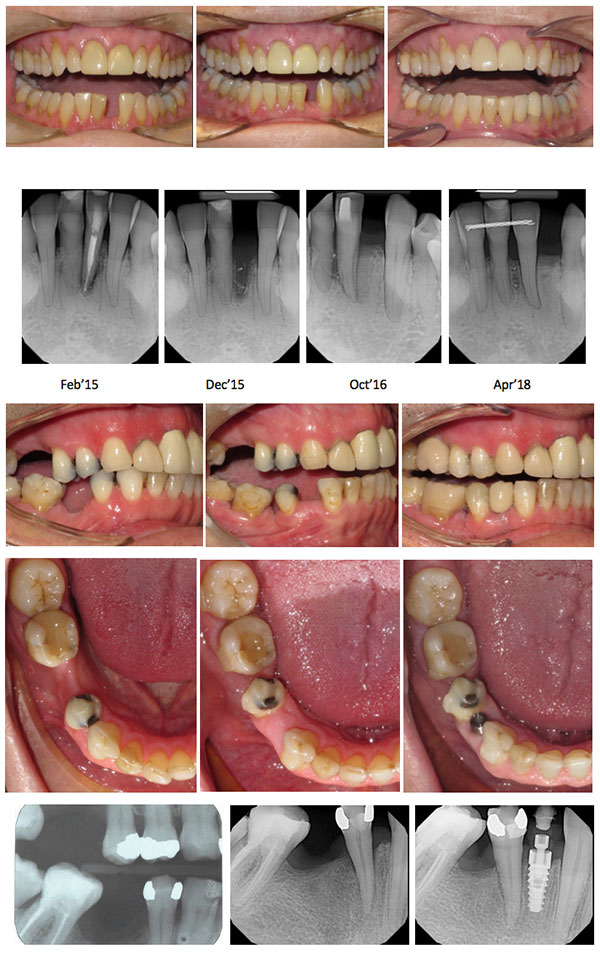 |
| Figure 6: A lack of bone for implants may require orthodontic induced bone generation via mesialization of the lateral incisor (top row). Autogenous bone generation can lead to long-term stability (second row). In one case, we saw orthodontic induced bone generation via 6.0-mm distalization of the first premolar (third row). We also have seen 3-D autogenous bone grafting with a 0% rejection rate (fourth row). Minimal root resorption is possible as well (fifth row). |
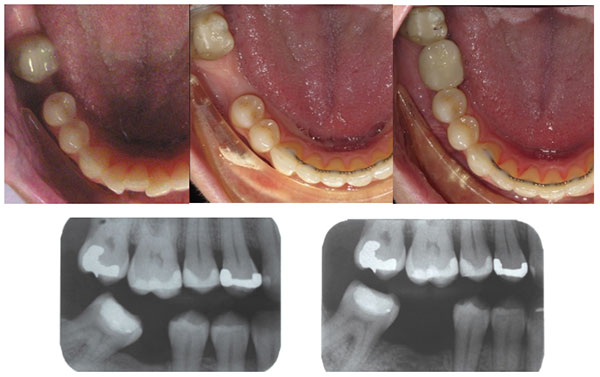 |
| Figure 7: To treat tipped teeth, the second molar can be uprighted prior to the implant placement (top row). The upper first molar can be intruded to the level plane of occlusion (bottom row). |
The Survey
I recently conducted a survey of 33 general dentists, informing them that orthodontic treatment can enhance the long-term predictability of restorative dental treatment by positioning the teeth in their optimal location within the dental arches. I then asked them to indicate six topics of interest regarding pre-treatment orthodontics and its restorative benefits from a list of 11 key restorative challenges. The results included:
- Extensive anterior tooth wear (Figure 1: 31 votes)
- Reduced vertical dimension (Figure 2: 26 votes)
- Aesthetic dilemma (Figure 3: 23 votes)
- Lack of interocclusal space (Figure 4: 22 votes)
- Posterior tooth erosion (Figure 5: 20 votes)
- Lack of bone for implants (Figure 6: 17 votes)
- Tipped teeth (Figure 7: 15 votes)
- Crowding (Figure 8: 13 votes)
- Fractured teeth (Figure 9: 12 votes)
- Periodontal concerns (Figure 10: 10 votes)
- Spacing between teeth (Figure 11: 9 votes)
During my 30 years of providing dental treatment and pursuing my expanding dental education, I have witnessed a growing emphasis on replacing missing teeth rather than the necessary education to enhance the long-term prognosis of the existing dentition. I feel there is a perfect opportunity for collaboration between the orthodontic community and restorative dentists to embrace the changing dental needs of the general public.
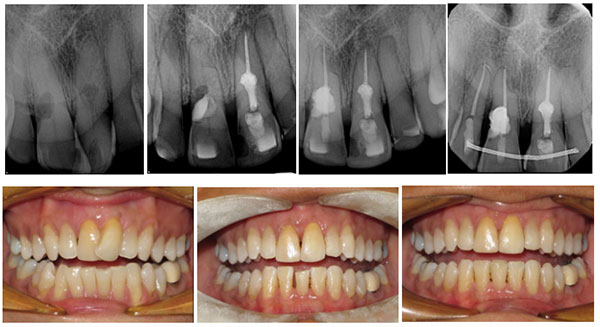 |
| Figure 8: The diagnosis of both internal and external resorption in the same patient is very unusual (top row). Endodontic, orthodontic, and restorative interdisciplinary treatment may be necessary (bottom row). |
 |
| Figure 9: When this upper left incisor was fractured, we used occlusion-induced orthodontic treatment to improve anterior guidance. |
To provide our patients the best possible dental treatment with the most favorable and predictable long-term prognosis in a minimally invasive manner, we should foster greater cooperation through education and dialogue. When we assess the need for orthodontic treatment as the initial step in the interdisciplinary approach to treatment planning, the patient will greatly benefit. I feel orthodontic dentistry has a vital place not only in today’s dental environment but also in the future.
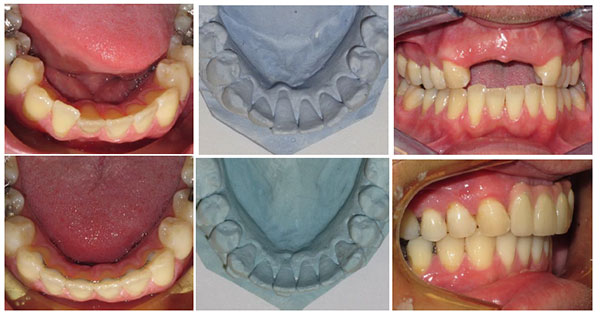 |
| Figure 10: Periodontal concerns may include severe gingival recession as well as the central incisor root emerging out of the bone. |
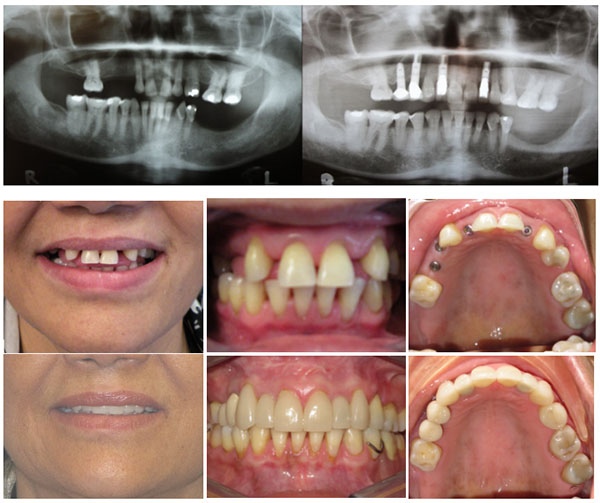 |
| Figure 11: Congenitally missing laterial lateral incisors can be replaced with implants subsequent to orthodontic treatment (top row). The maxillary cuspids were orthodontically moved from the lateral incisor sites to their desired cuspid location (middle and bottom rows). |
Dr. Schmidt practices general dentistry in Brampton, Ontario. He has been in practice with his wife, Dr. Tamara Sosath, for more than 30 years. He has always had an interest in orthodontics and has been using clear aligner therapy including Invisalign for his patients to establish a sound occlusion since 2010. He has been a member of SPEAR Education since 2014 and a frequent contributor to the Journal of the American Academy of Clear Aligners. He was a semi-finalist in 2013, and finalist in 2015, at the bi-annual Invisalign GP Summit. He can be reached at golfer_dad1@hotmail.com.
Related Articles
ALF Presents a New Solution for an Old Problem—Malocclusion
How You Can Stop the Epidemic of Smaller Jaws
Managing the Rising Trend of Adult Orthodontic Patients











